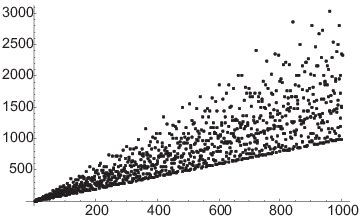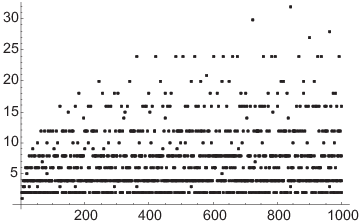Definition. The sum of divisors function is given by
![]()
As usual, the notation "![]() " as the
range for a sum or product means that d ranges over the positive divisors of n.
" as the
range for a sum or product means that d ranges over the positive divisors of n.
The number of divisors function is given by
![]()
For example, the positive divisors of 15 are 1, 3, 5, and 15. So
![]()
I want to find formulas for ![]() and
and ![]() in terms of the prime factorization of n. This will
be easy if I can show that
in terms of the prime factorization of n. This will
be easy if I can show that ![]() and
and ![]() are multiplicative. I can do most of the work in the
following theorem.
are multiplicative. I can do most of the work in the
following theorem.
Theorem. The divisor sum of a multiplicative function is multiplicative.
Proof. Suppose f is multiplicative, and let
![]() be the divisor sum of f. Suppose
be the divisor sum of f. Suppose ![]() . Then
. Then
![]()
Then
\cdot [D(f)](n) = \left(\sum_{a \mid m} f(a)\right) \left(\sum_{b \mid n} f(b)\right) = \sum_{a \mid m} \sum_{b \mid n} f(a)f(b).$$](divisor-functions12.png)
Now ![]() , so if
, so if ![]() and
and ![]() , then
, then ![]() . Therefore,
multiplicativity of f implies
. Therefore,
multiplicativity of f implies
![]()
Now every divisor d of ![]() can be written as
can be written as ![]() , where
, where ![]() and
and ![]() . Going the other way, if
. Going the other way, if ![]() and
and ![]() then
then ![]() . So I may set
. So I may set ![]() , where
, where ![]() , and replace the double sum with a single sum:
, and replace the double sum with a single sum:
![]()
This proves that ![]() is multiplicative.
is multiplicative.![]()
Theorem. (a) The sum of divisors function ![]() is multiplicative.
is multiplicative.
(b) The number of divisors function ![]() is multiplicative.
is multiplicative.
Proof. (a) The identity function ![]() is multiplicative:
is multiplicative: ![]() for all m, n, so obviously it's true for
for all m, n, so obviously it's true for
![]() . Therefore, the divisor sum of
. Therefore, the divisor sum of ![]() is multiplicative. But
is multiplicative. But
![]()
Hence, the sum of divisors function ![]() is multiplicative.
is multiplicative.
(b) The constant function ![]() is
multiplicative:
is
multiplicative: ![]() for
all m, n, so obviously it's true for
for
all m, n, so obviously it's true for ![]() . Therefore, the divisor sum of I is multiplicative.
But
. Therefore, the divisor sum of I is multiplicative.
But
![]()
Hence, the number of divisors function ![]() is multiplicative.
is multiplicative.![]()
I'll use multiplicativity to obtain formulas for ![]() and
and ![]() in terms of their
prime factorizations (as I did with
in terms of their
prime factorizations (as I did with ![]() ). First, I'll get the formulas in the case where n
is a power of a prime.
). First, I'll get the formulas in the case where n
is a power of a prime.
Lemma. Let p be prime.
(a) ![]() .
.
(b) ![]() .
.
Proof. The divisors of ![]() are 1, p,
are 1, p, ![]() , ...,
, ..., ![]() . So the sum of the divisors is
. So the sum of the divisors is
![]()
And since the divisors of ![]() are 1, p,
are 1, p, ![]() , ...,
, ..., ![]() , there are
, there are ![]() of them, and
of them, and
![]()
Theorem. Let ![]() , where the p's are distinct
primes and
, where the p's are distinct
primes and ![]() for all i. Then:
for all i. Then:
![]()
![]()
Proof. These results follow from the preceding
lemma, the fact that ![]() and
and ![]() are multiplicative, and the fact that the prime power
factors
are multiplicative, and the fact that the prime power
factors ![]() are pairwise relatively prime.
are pairwise relatively prime.![]()
Here is a graph of ![]() for
for ![]() .
.

Note that if p is prime, ![]() . This
gives the point
. This
gives the point ![]() , which lies on the line
, which lies on the line ![]() . This is the line that you see bounding the dots
below.
. This is the line that you see bounding the dots
below.
For each n, there are only finitely many numbers k whose divisor sum
is equal to n: that is, such that ![]() . For k
divides itself, so
. For k
divides itself, so
![]()
This says that k must be less than n. So if I'm looking for numbers
whose divisors sum to n, I only need to look at numbers less than n.
For example, if I want to find all numbers whose divisors sum to 42,
I only need to look at ![]() .
.
Here is a graph of ![]() for
for ![]() .
.

If p is prime, ![]() . Thus,
. Thus, ![]() repeatedly returns to the horizontal line
repeatedly returns to the horizontal line ![]() , which you can see bounding the dots below.
, which you can see bounding the dots below.
The formulas given in the theorem allow us to compute ![]() and
and ![]() by hand for at
least small values of n. For example,
by hand for at
least small values of n. For example, ![]() , so
, so
![]()
![]()
Example. Find all positive integers n such
that ![]() .
.
Since ![]() doesn't work, I can assume
doesn't work, I can assume ![]() .
.
I have
![]()
In other words, ![]() is a sum of distinct positive integers other than 1
and n that is equal to 7. I have to consider all possible ways of
doing this. I'll consider cases according to the largest element of
this sum, which is the largest divisor d of n other than 1 and n.
is a sum of distinct positive integers other than 1
and n that is equal to 7. I have to consider all possible ways of
doing this. I'll consider cases according to the largest element of
this sum, which is the largest divisor d of n other than 1 and n.
Suppose ![]() .
.
![]()
Then the only divisor of n other than 1 and n is 7. Since ![]() , I know
, I know ![]() for
for ![]() . But if
. But if ![]() , then 49 would be a divisor
of n other than 1 and n. Hence,
, then 49 would be a divisor
of n other than 1 and n. Hence, ![]() , and this is a
solution.
, and this is a
solution.
Suppose ![]() . Then the expression
. Then the expression ![]() must have the form
must have the form
![]() , which contradicts the assumption that the sum does
not include 1.
, which contradicts the assumption that the sum does
not include 1.
Suppose ![]() . Then the expression
. Then the expression ![]() must have the form
must have the form
![]() . In this case,
. In this case, ![]() .
.
Suppose ![]() . Then
. Then
![]()
But if ![]() , then
, then ![]() . So
. So ![]() must have the form
must have the form ![]() , contradicting the assumption that the sum does not
include 1.
, contradicting the assumption that the sum does not
include 1.
Suppose ![]() . Then
. Then
![]()
However, ![]() can't include 1,
and can't use 2 twice. Hence, this isn't possible.
can't include 1,
and can't use 2 twice. Hence, this isn't possible.
Suppose ![]() . Then the remaining terms in
. Then the remaining terms in ![]() must sum to 5
and can only use 1, which is excluded by assumption. Hence, this
isn't possible.
must sum to 5
and can only use 1, which is excluded by assumption. Hence, this
isn't possible.
Therefore, ![]() or
or ![]() .
.![]()
Copyright 2019 by Bruce Ikenaga